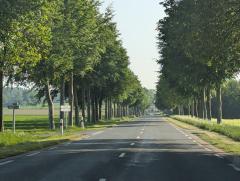 We flew into CDG and rented a car immediately. The day's itinerary was a loop through Picardy and northeastern Normandy along the Somme, the town of Amiens, and eventually to Rouen. It was pretty ambitious and we wanted to get away from suburban Paris quickly.
We flew into CDG and rented a car immediately. The day's itinerary was a loop through Picardy and northeastern Normandy along the Somme, the town of Amiens, and eventually to Rouen. It was pretty ambitious and we wanted to get away from suburban Paris quickly.
Here's a tip about doing a busy day of touring right after an overnight flight: every time we go on one of these trips, I get from my doctor a prescription for a single Ambien sleeping pill. As soon as the plane is in the air, I go to sleep and I wake up in my destination as if I'd spent the night in my own bed. It might work for you.
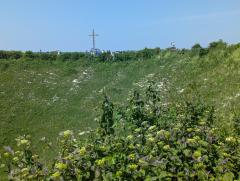 It wasn't long before the countryside was wide rolling fields and tree-lined roads, long vistas and occasional glimpses of the Somme. East of Amiens near Albert was some of the ugliest fighting of WWI, and there are memorials everywhere.
It wasn't long before the countryside was wide rolling fields and tree-lined roads, long vistas and occasional glimpses of the Somme. East of Amiens near Albert was some of the ugliest fighting of WWI, and there are memorials everywhere.
While I was planning the trip, I realized that my knowledge of WWI is pretty meager compared to that of WWII. It was a hugely important time, the end of an age of empires and the introduction of terrifying new technology that 19th-century tactics were unready for. On Google Maps I had seen Lochnagar Crater, so I read up on it and we visited it. It is beautiful, peaceful, and sad.
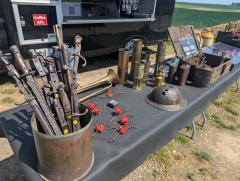 The explosion that created the crater was the largest man-made explosion in history to that time; some say it was heard in London. 60,000 lb of explosive was used. The crater is about 100 yards wide and 70 feet deep. It destroyed a German strongpoint along the trench lines, but the battle had been vicious for two weeks already and thousands of men were dead, captured, or evacuated. In the end it had no effect on the war. There are plaques mounted around the perimeter with the stories of the groups and individuals involved in this terrible event.
The explosion that created the crater was the largest man-made explosion in history to that time; some say it was heard in London. 60,000 lb of explosive was used. The crater is about 100 yards wide and 70 feet deep. It destroyed a German strongpoint along the trench lines, but the battle had been vicious for two weeks already and thousands of men were dead, captured, or evacuated. In the end it had no effect on the war. There are plaques mounted around the perimeter with the stories of the groups and individuals involved in this terrible event.
Near the crater was a food truck with cold drinks and snacks, and artifacts dug up by farmers over the 109 years since the event. We stayed here longer than we expected and we all felt impacted by the stories on the plaques.
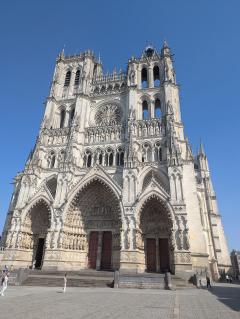 After this sobering visit we drove into the charming city of Amiens. We saw many cathedrals in France, including the famous ones like Rouen, Chartres, Sacre-Coeur, and Notre-Dame de Paris, but I thought this one was the prettiest and it had a feeling of happy people working in and near it. Amiens was comparatively easy to navigate, the streets were wide enough and there was parking available, so it was a nice way to get accustomed to city driving in France.
After this sobering visit we drove into the charming city of Amiens. We saw many cathedrals in France, including the famous ones like Rouen, Chartres, Sacre-Coeur, and Notre-Dame de Paris, but I thought this one was the prettiest and it had a feeling of happy people working in and near it. Amiens was comparatively easy to navigate, the streets were wide enough and there was parking available, so it was a nice way to get accustomed to city driving in France.
We strolled around and did some shopping, but we were really hungry. I had found a highly-regarded place online, but contrary to the Google Maps entry, it was closed that day. The owner was there; he apologized and recommended the Restaurant Bagdad, an Iraqi place next door. We had a wonderful lunch, and as we returned to the car, the owner of the first place called out to me - he had updated the hours information in his Google account!
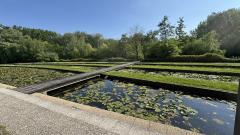 The Somme River passes through Amiens. It doesn't look like the Charles or the Merrimack - it's broad and braided, with scores of little islands. In the city, these islands form a complex called the Hortillonages, protected for farming since medieval times and still in use for that purpose. The southern end is a park where I was able to idle while Lorna and Melissa were able to enter the park and Melissa took this photo. They couldn't get onto the private island-farms, but you can see the pride and the care they take of this local treasure!
The Somme River passes through Amiens. It doesn't look like the Charles or the Merrimack - it's broad and braided, with scores of little islands. In the city, these islands form a complex called the Hortillonages, protected for farming since medieval times and still in use for that purpose. The southern end is a park where I was able to idle while Lorna and Melissa were able to enter the park and Melissa took this photo. They couldn't get onto the private island-farms, but you can see the pride and the care they take of this local treasure!
From Amiens we had some ground to cover to reach that night's hotel in Rouen. It was after 5pm and we still had four hours of daylight remaining, but we wanted some of that in Rouen.
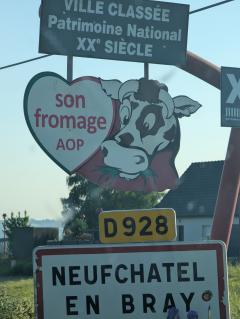 Normandy is the source of four classic cheeses: Neufchatel de Bray, Camembert, Livarot, and Pont-Leveque. The first was on our route.
Normandy is the source of four classic cheeses: Neufchatel de Bray, Camembert, Livarot, and Pont-Leveque. The first was on our route.
You may think of Neufchatel cheese not as a classic of French cuisine but as a bland blend of creamy cheese-like substance sometimes mixed with pimentos, sold in little juice glasses and most often served on Ritz crackers or Triscuits. The original Neufchatel is a delightful unassuming creamy brie-like bloomy-rind cheese that has traditionally been made in a heart-shaped mold for a thousand years in this little village. Somehow in the USA Neufchatel became synonymous with cream cheese in the 1960s, but the cheese makers of Neufchatel have had some success in name-protecting their special export and now the Kraft product in the jar says cream cheese instead of Neufchatel.
I had started the day as fresh as a daisy, but the ladies had not slept so well and they were pretty retired when we got to Rouen. The hotel is just a half-block from the cathedral, but it had a bizarre parking and entry system that exhausted the last of our energy and our patience, so we planned to sleep early and explore Rouen in the morning.
